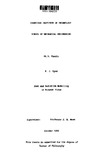JavaScript is disabled for your browser. Some features of this site may not work without it.
| dc.contributor.advisor | Moss, J. B. | |
| dc.contributor.author | Syed, K. J. | |
| dc.date.accessioned | 2014-01-06T15:09:21Z | |
| dc.date.available | 2014-01-06T15:09:21Z | |
| dc.date.issued | 1990-10 | |
| dc.identifier.uri | http://dspace.lib.cranfield.ac.uk/handle/1826/8070 | |
| dc.description.abstract | This study seeks to advance present modelling capabilities in respect of soot and thermal radiation emission from fires. Such developments are crucial to the improved estimate of the hazard potential of accidental fires. Radiation calculation requires the prediction of temperature and the concentrations of all radiatively important species. In hydrocarbon combustion, the key species are carbon dioxide, water vapour, carbon monoxide and particulate soot. In large hydrocarbon fires the latter is usually the dominant radiator. The detailed prediction of the gaseous species in turbulent combustion has previously been shown to be successfully achieved using laminar flamelet modelling in the fast chemistry limit. Soot, however, is governed by relatively slow formation processes which as yet remain poorly understood. The present study proposes a model for soot formation in turbulent non-premixed combustion which aims to address both the slow chemistry and turbulence interaction. In order to circumvent uncertainties in soot formation processes the model relies on empiricism, through the experimental investigation of a sooting laminar diffusion flame. The soot formation model is used to predict soot levels in a jet diffusion flame. Subsequent comparison with experimental data suggests the satisfactory performance of the model, but highlights soot oxidation to be a more significant problem. This stems from uncertainties associated both with instantaneous soot oxidation rate and the highly intermittent nature of this process in turbulent non-premixed flames. The soot formation model is also applied to the prediction of soot levels in a simulated buoyant methane fire, which supplement temperature and gaseous species predictions using a flamelet approach. Detailed predictions of spectrally resolved radiative intensity are then performed and compared with similarly detailed experimental data. The encouraging agreement with experiment allows the assessment of the effect of turbulence-radiation interaction. This is shown to be particularly important in buoyancy-driven fires and is most evident for the luminous radiation. This arises from the soot which is largely confined to narrow sheets that typically lie close to peak temperature zones. A strategy in which more representative soot-temperature correlations may be realised is also described. | en_UK |
| dc.language.iso | en | en_UK |
| dc.publisher | Cranfield University | en_UK |
| dc.title | Soot and radiation modelling in buoyant fires | en_UK |
| dc.type | Thesis or dissertation | en_UK |
| dc.type.qualificationlevel | Doctoral | en_UK |
| dc.type.qualificationname | PhD | en_UK |
